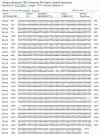First Molecular Identification of Caligus clemensi on Cultured Crimson Snapper Lutjanus erythropterus on Jerejak Island, Penang, Peninsular Malaysia
- PMID: 35215132
- PMCID: PMC8879188
- DOI: 10.3390/pathogens11020188
First Molecular Identification of Caligus clemensi on Cultured Crimson Snapper Lutjanus erythropterus on Jerejak Island, Penang, Peninsular Malaysia
Abstract
Fish parasites such as Caligus clemensi are a serious concern for cultured fish in many regions of the world, including Malaysia. This study was designed to elucidate the parasites' prevalence and intensity coupled with the morphology and molecular identification of C. clemensi on cultured Lutjanus erythropterus in Jerejak Island, Penang, Peninsular Malaysia. The study was carried out on 200 fish specimens of cultured L. erythropterus obtained from the GST group aquaculture farm. Parasites were collected from the infested part of L. erythropterus fish, and their prevalence and intensity were determined. The parasites were identified morphologically using a field emission scanning electron microscope. Molecular studies were performed through PCR amplification and sequencing. MEGA 5 was used to construct a phylogenetic tree using the pairwise distance method. The results showed that only the C. clemensi parasite was found prevalent on L. erythropterus fish with a prevalence and mean intensity (S.D) of 198 (99%) and 36.4 ± 12.2, respectively. The prevalence varied significantly with respect to fish length (p < 0.05). The nucleotide BLAST sequence for 18S ribosomal RNA partial sequences showed 97% with 100% query similarity, E-value 0 with C. clemensi with the accession number DQ123833.1. Conclusively, C. clemensi remains a major parasite of L. erythropterus in the study area.
Keywords: aquaculture; aquaculture industry; fish parasites; morphological identification; phylogenetic tree.
Conflict of interest statement
All the authors declare that there is no conflict of interest in this paper.
Figures






References
-
- Leaw Y.Y., Faizah S., Anil C., Kua B.C. Prevalence, mean intensity and site preference of Caligus rotundigenitalis Yü, 1933 (Copepoda: Caligidae) on cage cultured crimson snapper (Lutjanus erythropterus Bloch, 1790) from Bukit Tambun, Penang, Malaysia. Vet. Parasitol. 2012;187:505–510. doi: 10.1016/j.vetpar.2012.02.003. - DOI - PubMed
-
- Maran B.V., Seng L.T., Ohtsuka S., Nagasawa K. Records of Caligus (Crustacea: Copepoda: Caligidae) from marine fish cultured in floating cages in Malaysia with a redescription of the male of Caligus longipedis Bassett-Smith, 1898. Zool. Stud. 2009;48:797–807.
-
- Johnson S.C., Blaylock R.B., Elphick J., Hyatt K.D. Disease induced by the sea louse (Lepeophteirus salmonis) (Copepoda: Caligidae) in wild sockeye salmon (Oncorhynchus nerka) stocks of Alberni Inlet, British Columbia. Can. J. Fish. Aquat. Sci. 1996;53:2888–2897. doi: 10.1139/f96-226. - DOI
-
- See A.W.L. Animal protection laws of Singapore and Malaysia. Sing. J. Legal Stud. 2013:125–157.
LinkOut - more resources
Full Text Sources
Research Materials

